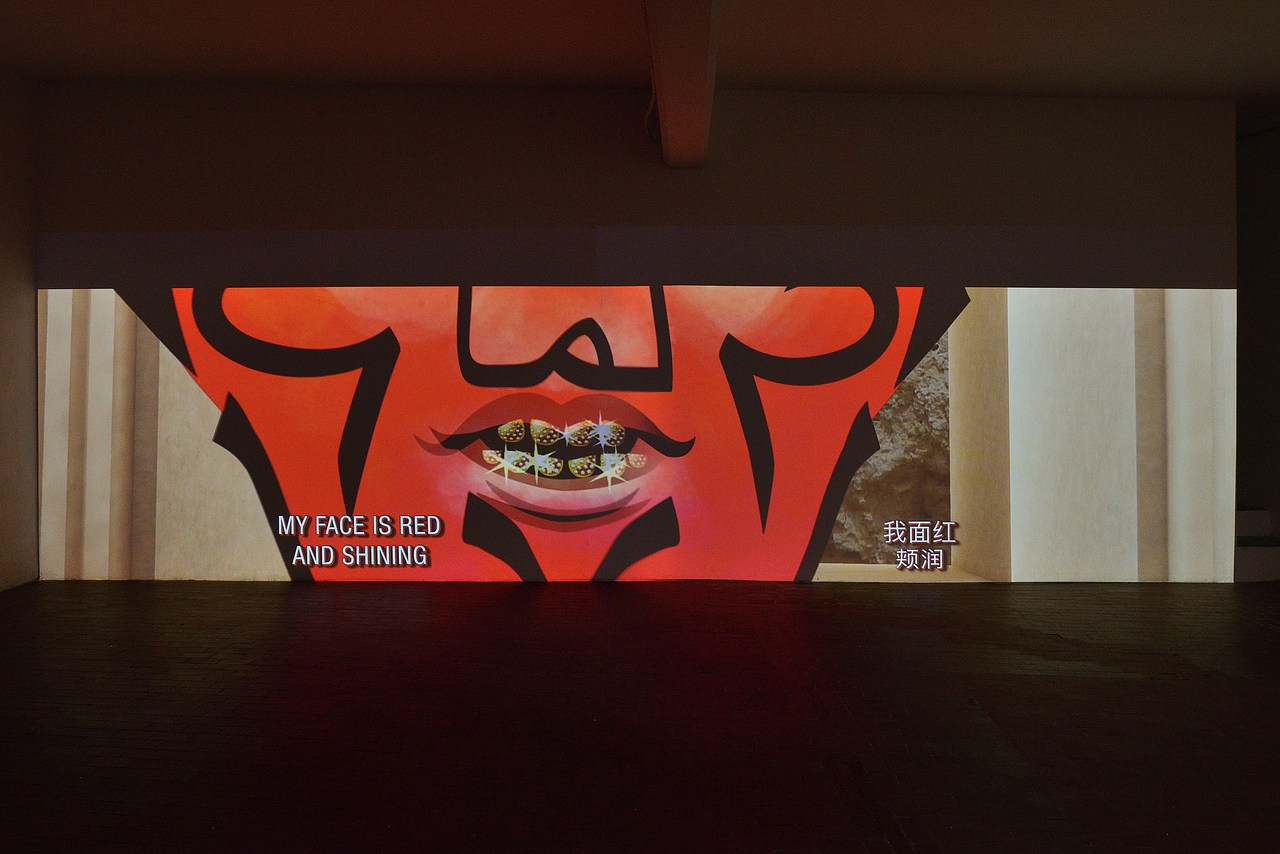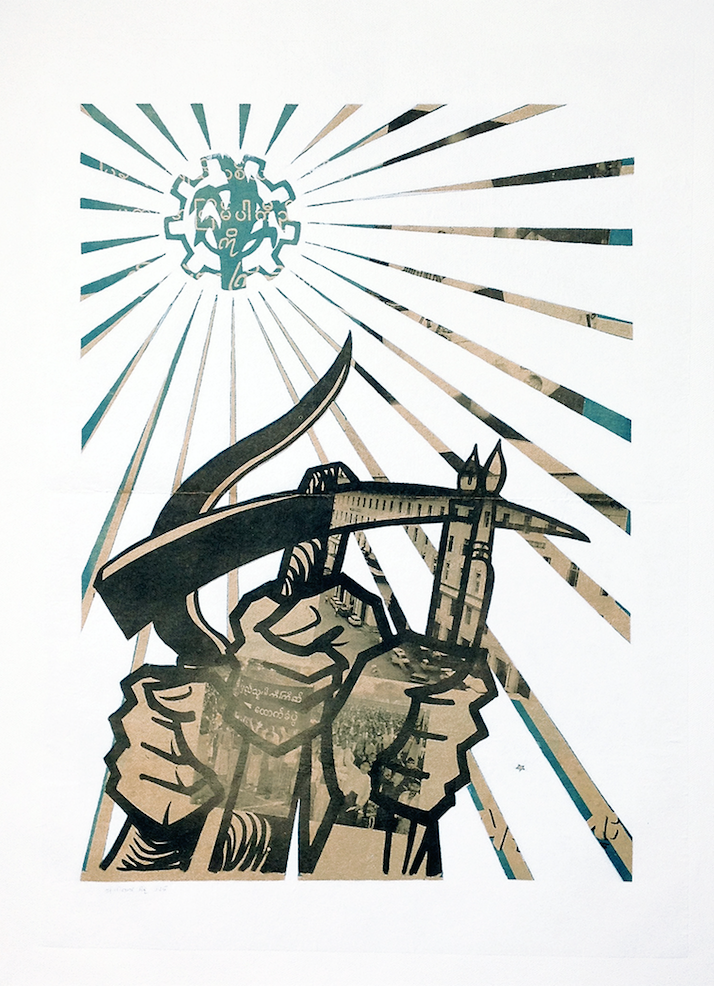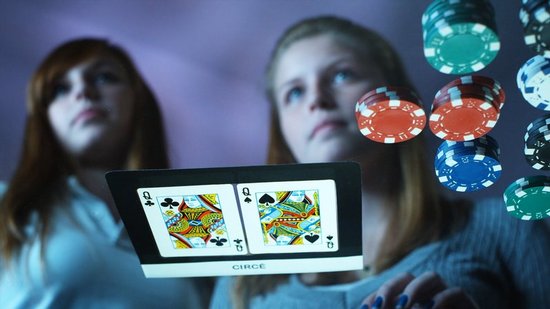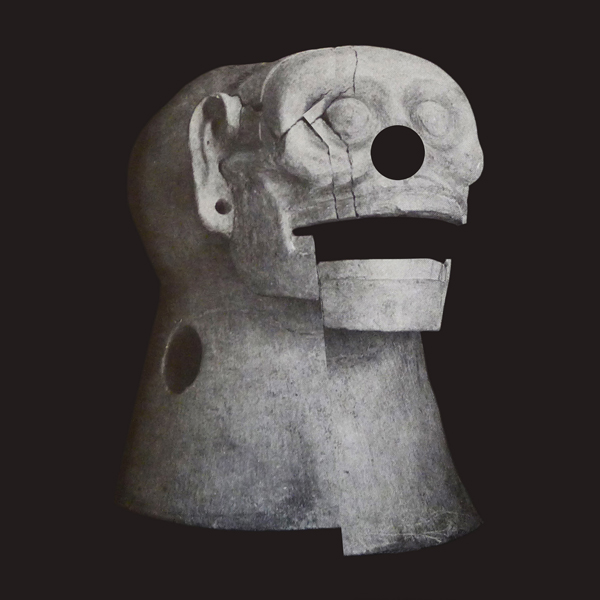
© » KADIST
Ei Arakawa and Sergei Tcherepnin
Part of a series entitled “Looking at Listening”, 2011, the piece invited the spectator to experiment and consider sound as a kinetic and synesthetic process, where multiple experiences and senses can cross. The presented photographs were selected from the New York Public Library and found in an archive called ‘Listening,’ with the sub-genres ‘town meetings,’ ‘investigation,’ ‘audiences 1960–1970’ and ‘conversation.’ Taking the photographs from the city’s archive of frozen moments of audio exchange, Arakawa and Tcherepnin give sound and movement back to past moments. In each of the photographs, people are listening in different situations—public, and private.

© » KADIST
Victor & Sergiy Kochetov
Having a press card allowed Viktor Kochetov to photograph freely in public places, access to which was strictly regulated for amateurs. Seeking a way to transgress the reportage canon, the Kochetovs employed a method of taking images of large gatherings that emphasize the structure and “patterns” of the imaginary collective body. His 1978 photo of women sorting corn, titled Working women, builders of communism, are sorting corn… , is organized on this principle: the scarfs on the workers’ heads are perceived as an element of uniform, which creates a visual rhythm.

© » KADIST
Victor & Sergiy Kochetov
Ukraine-Russia / Volleyball by Viktor and Sergiy Kochetov features a concrete monument of women volleyball players before the railway station in the village of Vodyanoye, Kharkiv region. It’s a typical Soviet sculptural composition, thousands of which were casted in the USSR during this period. Many can still be found all over post-Soviet territories, leading to regular debates on the destiny of this visual heritage in Ukraine.

© » KADIST
Sergio De La Torre
Nuevo Dragon City is a reenactment of a historical event from 1927 in which six Chinese were either trapped or voluntarily hid themselves inside a building in northern Mexico. Working with this unsettled mystery, De La Torre’s video inquires into the historical and continuing tensions between Chinese and Mexicans. As such, Nuevo Dragon City depicts a symbolic act of self-entrapment in which six untrained actors of Chinese descent silently blockade themselves inside in an empty Tijuana storefront.

© » KADIST
Gabriella and Silvana Mangano
There is no there by Gabriella and Silvana Mangano is a black and white looped video with sound, in conjunction with a live performance. The work is inspired by the Blue Blouse, a political propaganda theater movement which spread across the Soviet Union in the mid-1920s. More specifically, the work takes the form of ‘Living Newspapers’, which were performances based on topical news events.

© » KADIST
Slavs and Tatars
Wheat Mollah ( 2011) is one of Slavs and Tatars composite object. The title Wheat Mollah has various interpretations, from “master” or spiritual authority for Shiites and “friend” for Sunnis. The turban is also worn in a diversity of cultures and religions in Africa, Asia and India.

© » KADIST
Michelle and Noel Keserwany
Les Chenilles by Michelle and Noël Keserwany is a sensual film that translates the source of women’s oppression into the means for their liberation. In this narrative film, protagonists Asma and Sarah meet while working as waitresses in France. They both come from the Levant and, each in their own way, carry burdens of the past and the consequences of colonialism.
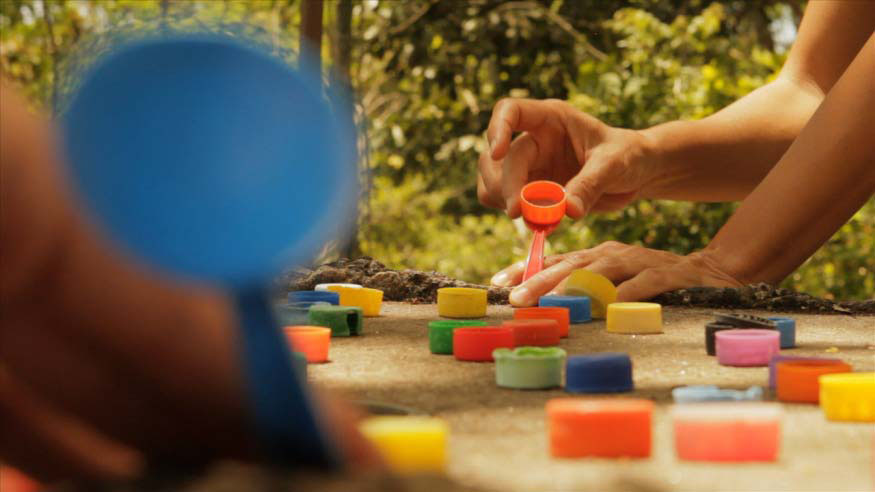
© » KADIST
Donna Conlon and Jonathan Harker
In Tapitapultas (2012), Donna Conlon and Jonathan Harker comment on mass consumerism and pollution by way of a game they invented. The artists used disposable spoons as catapults to shoot thousands of plastic bottle caps at a hole in a concrete platform. The platform was once part of a U. S. military installation in the Panama Canal Zone, and it is now an observation deck in a nature park.

© » KADIST
Köken Ergun and Tashi Lama
Nepal and China signed an agreement for the Belt and Road Initiative (BRI) in 2017. The BRI is a strategy that was set forth by China in 2013 to expand its influence by building a network of economic corridors around the globe. BRI projects in Nepal include the Kathmandu-Kerung Railway, the Galchhi-Rasuwagadhi-Kerung 400 kilovolt transmission line, the 762 megawatt Tamor hydroelectric dam, and the 426 megawatt Phukot Karnali run-of-the-river hydropower project.

© » KADIST
Jay Chung and Takeki Maeda
Jay Chung and Q Takeki Maeda remake a clip from the 1970s they found on the internet, and without really changing this archive material, displace it by imitating the staging and the acting with scrupulous precision. The slightest details are reproduced identically with great minutiae. The facial expressions are absurd, the prim attitude makes no sense.

© » KADIST
Pooja Gurung and Bibhusan Basnet
DADYAA: The Woodpeckers of Rotha by Pooja Gurung and Bibhusan Basnet illuminates a unique and seldom seen international perspective on indigenous cultures and contemporary social issues in the Nepali context. A small masterpiece, the work engages with one of the most pressing social issues in Nepal, mass migration and the dissolving of social fabric in rural areas. The story begins with an old couple, Atimaley and Devi, who live in a village in Jumla, in the highlands of Western Nepal.

© » KADIST
Köken Ergun and Satyam Mishra
Nepal and China signed an agreement for the Belt and Road Initiative (BRI) in 2017. The BRI is a strategy that was set forth by China in 2013 to expand its influence by building a network of economic corridors around the globe. BRI projects in Nepal include the Kathmandu-Kerung Railway, the Galchhi-Rasuwagadhi-Kerung 400 kilovolt transmission line, the 762 megawatt Tamor hydroelectric dam, and the 426 megawatt Phukot Karnali run-of-the-river hydropower project.

© » KADIST
Musquiqui Chihying and Gregor Kasper
Addressing the legacy of colonialism, The Guestbook by Musquiqui Chihying and Gregor Kasper is a slow-paced, black-and-white film exploring the German colony of Togoland, now the Republic of Togo. The guestbook in question—a thin, battered copy that Do Do, the Togolese protagonist of the film, finds in Berlin’s State Library—is filled with the signatures of colonial-era explorers. The plot follows Do Do as he seeks out Treptower Park, where the JAZZ musician Kwassi Bruce was once exhibited in a human zoo in the first German Colonial Exhibition.

© » KADIST
Jonas Van and Juno B
Jonas Van and Juno B’s video work Kebranto is anchored by the figure of Boitatá, a snake that is part of the imaginary Guaraní communities that live between the current nation-states of Argentina, Brazil, Paraguay, and Uruguay. The mythical figure Boitatá is a protector of jungles and forests. In GuaraníBoitatá is the union of two words: Mbói (snake) and tatá (fire).

© » KADIST
Chantal Edie and Zacharie Ngnogue
Au non de la liberté (Tiko drink Kumba drunk) is a photographic series by Zacharie Ngnogue and Chantal Edie that considers the correlation between those who hold power in Cameroon and how their actions affect the populations they rule in often compromising ways. “Tiko drink-Kumba drunk” is an adage that is commonly used in the Southwest province of Cameroon to speak of how one’s actions affect others. Civil liberties are next to non-existent in Cameroon, the law is lawless, and structured in a way that is intended to attack its citizens’ human rights.

© » KADIST
Angela Detanico and Rafael Lain
Letters of the Greek alphabet glisten on a black background. When a letter appears, there is a sound. Each letter corresponds to a star in the sky.

© » KADIST
Raimond Chaves and Mantilla Gilda
Many of Chaves and Gilda’s works use recycled cardboard. For Partituras, they arranged stacks of cardboard into long rectangles on the ground, which are visually analogous to fields of graphite in Chaves’s pencil drawings. While the blocks have a spare presence in space, they exist more full solidity within their borders, and the recycled nature of the cardboard adds some play into the clean minimalist rectangles and cubes.

© » KADIST
Chantal Edie and Zacharie Ngnogue
Au non de la liberté (Tiko drink Kumba drunk) is a photographic series by Zacharie Ngnogue and Chantal Edie that considers the correlation between those who hold power in Cameroon and how their actions affect the populations they rule in often compromising ways. “Tiko drink-Kumba drunk” is an adage that is commonly used in the Southwest province of Cameroon to speak of how one’s actions affect others. Civil liberties are next to non-existent in Cameroon, the law is lawless, and structured in a way that is intended to attack its citizens’ human rights.

© » KADIST
Ana Vaz
Há Terra! (There Is Land!) is a short film by Ana Vaz that picks up on the artist’s previous film A Idade da Pedra (2013), in which Vaz imagined premodernity in her native Brazil.

© » KADIST
Lenka Clayton and Phillip Andrew Lewis
Five Hundred Twenty-Four, a single-channel video installation by Lenka Clayton and Phillip Andrew Lewis, features singers from over twenty Cleveland-area choirs counting numbers in an iterative process: one person sings “one”, then two people sing “two”, and so forth, to 524. Each choir was filmed separately, and the artists weave together the audio while the video features each choir individually. The juxtaposition of different contexts in which singing occurs functions as an embedded sociological study of various communities throughout the region.

© » KADIST
Jane Jin Kaisen and Guston Sondin-Kung
The Woman, The Orphan, and The Tiger begins with the sound of women’s voices describing histories of violence, of things repressed and silenced. Gradually, their voices accumulate into a cacophony of pure sonic intensity against an extreme slow-motioned image of a woman survivor of Japan’s military sexual slavery who, in the absence of words to accurately account for her suffering, gets up and walks into the center of a war crimes tribunal court room and gestures wildly before she faints. This work by Jane Jin Kasen and Guston Sondin-Kung explores ways in which trauma is passed on from previous generations to the present through a sense of being haunted.

© » KADIST
Etel Adnan and Lynn Marie Kirby
Drawing & Print (Drawing & Print)
In conjunction with KADIST’s 2017 exhibition If Not Apollo, the Breeze , artist and filmmaker Lynn Marie Kirby performed Transmissions , a video and live reading created with longtime collaborator Etel Adnan. Inspired by time spent together in Paris, the piece incorporated open-ended conversation about the oracle, Mount Tamalpais (a subject of long-standing fascination for Adnan and the subject of hundreds of works), and a suite of collaborative drawings. The drawings, made in India ink and created spontaneously, are remarkable evidence of two lives, minds, and hands in dialogue.
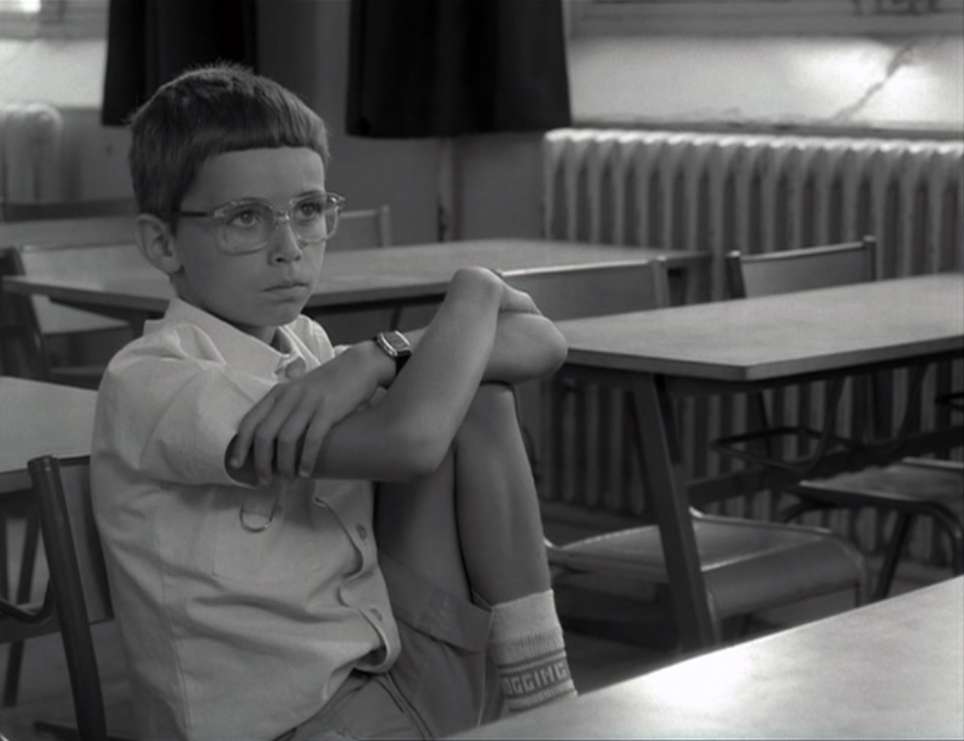
© » KADIST
Jean-Marie Straub and Danièle Huillet
En rachâchant is based on the short story Ah! Ernesto! (1971) by Marguerite Duras in which the child Ernesto does not want to go to school anymore as all that he is taught are things he does not know.

© » KADIST
Leung Chi Wo and Wong Sara
Photojournalist with Two Cameras restages a portrait of a photojournalist from the background of an old photograph of protest published in South China Morning Post on January 10, 2010 under the headline “Return of the Radicals: Recent angry protests are nothing new.” The photojournalist in the photograph, probably from a protest of earlier decades, was capturing the scene of a protester’s arrest while wearing two cameras. January of 2010 was a time of pro-Democracy demonstrators called for the release of activist Liu Xiaobo, drafter of the Charter 08 manifesto calling for the end of authoritarian rule, was sentenced to 11 years in prison one month earlier. Leung’s isolating and highlighting of the photographer by bringing him from the original photograph’s background to the foreground of his studio shot calls attention to the two older cameras and the journalist’s retro-style clothing.

© » KADIST
João Maria Gusmão and Pedro Paiva
The artist duo João Maria Gusmão and Pedro Paiva traveled to Japan for a month to make a series of short 16mm films, often shot in slow-motion. This film, shown in continuous loop, has a run-time of just under 3 minutes, and is presented without sound. It captures a traditional Shisa (combination of a dog and lion from Okinawan mythology) animated by an invisible person.

© » KADIST
Jordan Ann Craig
Something To Do With Being Held by Jordan Ann Craig is inspired by a Cheyenne bead bag. Intrigued by the two shades of blue used for the source object (a deep dusty blue and a bold vivid cobalt blue) the artist replicated these shades in her painting. Craig then added in her own colors, including the pink-orange hues, to achieve a bold but soft quality about the work, as she states that she intended the work to convey vulnerability.

© » KADIST
Mary Ann Aitken
Untitled (Boom Box, Double-Sided) by Mary Ann Aitken is representational painting of a boom box on an unconventionally long canvas painted on both sides, to mimic the scale and appearance of the actual appliance. Known for going against trends, Aitken often favored dimensions, such as the square, that were otherwise considered out of style in contemporary painting. In this double-sided painting, one side depicts the titular boombox set up—a boxy cassette player, flanked by a pair of stereo speakers in front of wood panelling.

© » KADIST
Mary Ann Aitken
Untitled (Diptych) by Mary Ann Aitken is a pair of paintings; one entirely abstract and the other a hybrid of representational and abstract elements. The left-side painting is a cacaphonous all over composition of brushstrokes layered in the artist’s signature primary colors. In the same color scheme, the right-side painting portrays a still life with an arrangement of flowers as its focal point, with marks and splatter spilling from the left-side composition into the right.

© » KADIST
Victor & Sergiy Kochetov
According to Viktor Kochetov, Meeting with the awaited guest / Yellow Bows is the first hand-colored print he ever made. Although this might well be a part of the artist’s mythology, this image perfectly demonstrates the methodology the Kochetovs used in their work. The snapshot itself was created during a journalistic assignment to document the meeting between a WWII veteran and school children in the Kharkiv region.

© » KADIST
Sergio De La Torre
This is not in Spanish looks at the ways in which the Chinese population in Mexico navigates the daily marginalization they encounter there. The neon translates as “this is not in Spanish,” making reference to both the famous Rene Magritte painting “Ceci n’est pas une pipe” as well as signs posted in the windows of Chinese establishments in Mexico.
Chantal Edie and Zacharie Ngnogue
Chantal Edie and Zacharie Ngnogue are a photography duo who channel their personal experiences into social commentaries...
Victor & Sergiy Kochetov
Viktor Kochetov became engaged in photography in 1968 and was also a professional photographer in film and photo laboratories...
Ad Minoliti
Ad Minoliti is a painter who combines the pictorial language of geometric abstraction with the perspective of queer theory...
Ana Vaz
Ana Vaz is an artist and filmmaker whose works speculate on the relationships between self and other, and myth and history, through a cosmology of signs, references, and perspectives...
Leung Chi Wo and Wong Sara
Leung Chi Wo tends to highlight in his art the boundaries between viewing and voyeurism, real and fictional, and art and the everyday...
Sergio De La Torre
Sergio De La Torre has worked with and documented the manifold ways in which citizens reinvent themselves in the city they inhabit, as well as the site-specific strategies they deploy to move “in and out modernity.” De La Torre often collaborates with his subjects, resulting in both intimate and critical reflections on topics like housing, immigration, and labor...
Mary Ann Aitken
Mary Ann Aitken was known to be very private about her art practice; she was considered somewhat of an outsider by her peers affiliated with the second wave of Detroit’s Cass Corridor arts movement...
An-My LE
- location: New York, New York
- year born: 1960
- gender: female
- home town: Saigon, Vietnam
Ho Rui An
The artist, writer, and researcher Ho Rui An probes histories of globalization and governance, performing a detournement of dominant semiotic systems across text, film, installation, and lecture...
John Wood and Paul Harrison
John Wood and Paul Harrison have been working collaboratively since 1993, producing single screen and installation-based video works...
Michelle and Noel Keserwany
Michelle and Noël Keserwany compose and perform their own songs, as well as contribute to the illustrations and animations featured in the videos they produced...
Ei Arakawa and Sergei Tcherepnin
Ei Arakawa and Sergei Tcherepnin began their audio-visual and performative collaboration in 2007...
Musquiqui Chihying and Gregor Kasper
Through his artistic career, Musquiqui Chihying has striven to dislocate and reconstruct established modes of behavior within systems and structures of power...
Jane Jin Kaisen and Guston Sondin-Kung
Working with narrative experimental film, multi-channel video installation, performative video art, photography, and text, Jane Jin Kaisen engages themes of memory, trauma, migration and translation at the intersection of personal and collective histories...
Donna Conlon and Jonathan Harker
- location: Panama City, Panama
- year born: 1966
- nationality: American and Ecuadorian
Tun Win Aung and Wah Nu
Wah Nu and Tun Win Aung, respectively born in 1977 and 1975, Yangon, Myanmar...
Etel Adnan and Lynn Marie Kirby
Visual artist, poet, and essayist Etel Adnan writes what must be communicated through language, and paints what cannot...
Jonas Van and Juno B
Although Jonas Van and Juno B do not belong to a collective, this collaborative video reflects their individual practices and their complex subjectivities...
Pauline Boudry and Renate Lorenz
Working together since 2007, artist duo Pauline Boudry and Renate Lorenz conduct research on the heritage of cultural and gender studies, concentrating primarily on gender discourses and the notion of queer...
Pooja Gurung and Bibhusan Basnet
Pooja Gurung and Bibhusan Basnet have a joint practice that merges film and visual art...
Sergio Rojas Chaves
Sergio Rojas Chaves’s work focuses on contemporary depictions of animals and of plants and affective approaches to biology...
Olive Martin and Patrick Bernier
Patrick Bernier and Olive Martin are a duo of artists collaborating since 1999...
Jordan Ann Craig
Jordan Ann Craig is a Northern Cheyenne artist born and raised in the Bay Area; she invests her work with a strong interest in Indigenous culture and the history of its destruction by settlers...
Angela Detanico and Rafael Lain
Linguists, semiologists, and graphic designers by training, Angela Detanico and Raphaël Lain consider the use of graphic signs in society...
Ana Navas
Ana Navas’s practice deals with the vulgarization of modern art, understanding the term vulgar in its original sense of being appropriated by common people...
Jay Chung and Takeki Maeda
Jay Chung and Takeki Maeda’s practice is characterized by performance, which often involves weighty unsettling humour...
Maayan Amir and Ruti Sela
Maayan Amir and Ruti Sela, two young Israeli women artists work collaboratively or individually by project...
Gabriella and Silvana Mangano
Gabriella Mangano and Silvana Mangano are an artistic duo and identical twins known for their collaborative and performative video practice...
Christine Sun Kim and Thomas Mader
Christine Sun Kim and Thomas Mader have been collaborating for the last 5 years, covering communication in a variety of formats such as recording an overnight shipment from Berlin to New York ( Recording Contract , 2013), compiling 24 hours of invited contributors’ studio time ( Busy Day , 2014), and using the arm game, a combination of body and face, in order to describe a series awkward situations ( Classified Digits , 2016)....

© » APERTURE
about 4 months ago (12/01/2023)
For the past two decades, An-My Lê has used photography to examine her personal history and the legacies of US military power, probing the tension between experience and storytelling....
-
1970-1979
Victor & Sergiy Kochetov
1978Having a press card allowed Viktor Kochetov to photograph freely in public places, access to which was strictly regulated for amateurs...
-
1980-1989
Jean-Marie Straub and Danièle Huillet
1982En rachâchant is based on the short story Ah! Ernesto! (1971) by Marguerite Duras in which the child Ernesto does not want to go to school anymore as all that he is taught are things he does not know...
Victor & Sergiy Kochetov
1982According to Viktor Kochetov, Meeting with the awaited guest / Yellow Bows is the first hand-colored print he ever made...
-
1990-1999
Victor & Sergiy Kochetov
1992Ukraine-Russia / Volleyball by Viktor and Sergiy Kochetov features a concrete monument of women volleyball players before the railway station in the village of Vodyanoye, Kharkiv region...
John Wood and Paul Harrison
1996One of John Wood and Paul Harrison’s earliest works, Device features Harrison performing a series of actions, assisted by the titular ‘devices’, that use physics to force his body into unusual and uncomfortable positions...
John Wood and Paul Harrison
19973-Legged is an early video work by John Wood and Paul Harrison in which they appear with their legs tied together (as one would do in a three-legged race)...
-
2000-2009
Mary Ann Aitken
2002Untitled (Boom Box, Double-Sided) by Mary Ann Aitken is representational painting of a boom box on an unconventionally long canvas painted on both sides, to mimic the scale and appearance of the actual appliance...
Maayan Amir and Ruti Sela
2003In Beyond Guilt the two artists create a portrait of our generation in three parts...
Sergio De La Torre
2008Nuevo Dragon City is a reenactment of a historical event from 1927 in which six Chinese were either trapped or voluntarily hid themselves inside a building in northern Mexico...
Jay Chung and Takeki Maeda
2009Jay Chung and Q Takeki Maeda remake a clip from the 1970s they found on the internet, and without really changing this archive material, displace it by imitating the staging and the acting with scrupulous precision...
Mary Ann Aitken
2009Untitled (Diptych) by Mary Ann Aitken is a pair of paintings; one entirely abstract and the other a hybrid of representational and abstract elements...
Pauline Boudry and Renate Lorenz
2009Salomania sees choreographer and filmmaker Yvonne Rainer and artist Wu Tsang rehearse scenes from Valda’s Solo , a chapter of a film Rainer made in 1972 after having seen women perform the dance of the seven veils in Alla Nazimova’s 1923 silent film Salomé ...
-
2010-2019
Jane Jin Kaisen and Guston Sondin-Kung
2010The Woman, The Orphan, and The Tiger begins with the sound of women’s voices describing histories of violence, of things repressed and silenced...
Leung Chi Wo and Wong Sara
2010Photojournalist with Two Cameras restages a portrait of a photojournalist from the background of an old photograph of protest published in South China Morning Post on January 10, 2010 under the headline “Return of the Radicals: Recent angry protests are nothing new.” The photojournalist in the photograph, probably from a protest of earlier decades, was capturing the scene of a protester’s arrest while wearing two cameras...
Olive Martin and Patrick Bernier
2010The Mohawk, the emblematic Frontier river in the period of American colonisation, is here a cable of data transmission, and the 7 Sultans Casino is a virtual destination, one of the three hundred online casinos hosted by the servers located in Kahnawake, a small native american indian reserve to the south of Montreal...
The Propeller Group and Superflex
2010Fade In (the whole title of the film is actually the entire five page script) is a collaboration with the Danish artist collective Superflex (group of freelance artist–designer–activists committed to social and economic change, founded in 1993 by Jakob Fenger, Rasmus Nielsen and Bjørnstjerne Christiansen)...
Võ An Khánh
2010In Extra Curriculum Political Science Class 7/1972 , a group of women walk bare-foot and single file towards Dat Mui Mangrove in Ca Mau Province to attend ‘political science class’...
Leung Chi Wo and Wong Sara
2010Office Lady with a Red Umbrella restages a figure from a 1980 postcard made from a photograph from 1950’s...
An-My LE
2010The print Patient Admission, US Naval Hospital Ship Mercy, Vietnam (2010) features an Asian Buddhist monk and an American Navy Solider on board the Mercy ship –one of the two dedicated hospital ships of the United States Navy– sitting upright in their chairs and adopting the same posture...
Ei Arakawa and Sergei Tcherepnin
2011Part of a series entitled “Looking at Listening”, 2011, the piece invited the spectator to experiment and consider sound as a kinetic and synesthetic process, where multiple experiences and senses can cross...
Sergio De La Torre
2011This is not in Spanish looks at the ways in which the Chinese population in Mexico navigates the daily marginalization they encounter there...
Tun Win Aung and Wah Nu
2011Tun Win Aung and Wah Nu initiated the series 1000 Pieces (of White) in 2009, as a way to produce objects and images as a portrait of their shared life as partners and collaborators...
Ana Teresa Fernández
Drawing & Print
2011(Drawing & Print) The artist writes about her work Borrando la Frontera, a performance done at Tijuana/San Diego border: “I visually erased the train rails that serve as a divider between the US and Mexico...
Donna Conlon and Jonathan Harker
2012In Tapitapultas (2012), Donna Conlon and Jonathan Harker comment on mass consumerism and pollution by way of a game they invented...
Ana Roldán
2012Ana Roldán’s Primeval forms series looks up close at the fecund shapes of plants often found in the artist’s native Mexico...
Ana Roldán
2012Ana Roldán’s Displacements works use images taken from a 1970s exhibition catalogue for an exhibition called The Death in Mexico...
Gabriella and Silvana Mangano
2015There is no there by Gabriella and Silvana Mangano is a black and white looped video with sound, in conjunction with a live performance...
João Maria Gusmão and Pedro Paiva
2015The artist duo João Maria Gusmão and Pedro Paiva traveled to Japan for a month to make a series of short 16mm films, often shot in slow-motion...
Christine Sun Kim and Thomas Mader
2016Indexes that either allow or inhibit the establishment of communication exist in both signed as well as spoken languages...
Etel Adnan and Lynn Marie Kirby
Drawing & Print
2017(Drawing & Print) In conjunction with KADIST’s 2017 exhibition If Not Apollo, the Breeze , artist and filmmaker Lynn Marie Kirby performed Transmissions , a video and live reading created with longtime collaborator Etel Adnan...
Pooja Gurung and Bibhusan Basnet
2018DADYAA: The Woodpeckers of Rotha by Pooja Gurung and Bibhusan Basnet illuminates a unique and seldom seen international perspective on indigenous cultures and contemporary social issues in the Nepali context...
Sergio Rojas Chaves
2018Más vale pájaro en mano que cien volando (A bird in the hand is worth more than two in the bush) is part of a larger series of pieces developed by Sergio Rojas Chaves in Honduras in 2018 that engages with tourism and in particular amateur-ornithologists that overrun the country in pursuit of the nation’s extreme diversity of bird species...
John Lucas and Claudia Rankine
Drawing & Print
2018(Drawing & Print) Historically, blondeness has been a signifier for desirability and beauty, speaking to “purity” — the purity of whiteness — like no other bodily attribute except, perhaps, blue eyes...
Musquiqui Chihying and Gregor Kasper
2019Addressing the legacy of colonialism, The Guestbook by Musquiqui Chihying and Gregor Kasper is a slow-paced, black-and-white film exploring the German colony of Togoland, now the Republic of Togo...
Jordan Ann Craig
2019Something To Do With Being Held by Jordan Ann Craig is inspired by a Cheyenne bead bag...
Ana María Millán
2019Interested in role-play and videogames, Ana María Millán developed workshops with different communities in order to create characters and scenarios for her animations, often in collaboration with a choreographer...
Ad Minoliti
2019In Ad Minoliti’s expansive three-panel painting Abstracción geométrico-galáctica the artist’s hallmark geometric abstractions serve as playful substitutes for more straightforward depictions of the world...
-
2020-2029
Chantal Edie and Zacharie Ngnogue
2020Au non de la liberté (Tiko drink Kumba drunk) is a photographic series by Zacharie Ngnogue and Chantal Edie that considers the correlation between those who hold power in Cameroon and how their actions affect the populations they rule in often compromising ways...
Chantal Edie and Zacharie Ngnogue
2020Au non de la liberté (Tiko drink Kumba drunk) is a photographic series by Zacharie Ngnogue and Chantal Edie that considers the correlation between those who hold power in Cameroon and how their actions affect the populations they rule in often compromising ways...
Chantal Edie and Zacharie Ngnogue
2020Au non de la liberté (Tiko drink Kumba drunk) is a photographic series by Zacharie Ngnogue and Chantal Edie that considers the correlation between those who hold power in Cameroon and how their actions affect the populations they rule in often compromising ways...
Jonas Van and Juno B
2021Jonas Van and Juno B’s video work Kebranto is anchored by the figure of Boitatá, a snake that is part of the imaginary Guaraní communities that live between the current nation-states of Argentina, Brazil, Paraguay, and Uruguay...
Michelle and Noel Keserwany
2022Les Chenilles by Michelle and Noël Keserwany is a sensual film that translates the source of women’s oppression into the means for their liberation...
Köken Ergun and Tashi Lama
2022Nepal and China signed an agreement for the Belt and Road Initiative (BRI) in 2017...
Köken Ergun and Satyam Mishra
2022Nepal and China signed an agreement for the Belt and Road Initiative (BRI) in 2017...
Lenka Clayton and Phillip Andrew Lewis
2022Five Hundred Twenty-Four, a single-channel video installation by Lenka Clayton and Phillip Andrew Lewis, features singers from over twenty Cleveland-area choirs counting numbers in an iterative process: one person sings “one”, then two people sing “two”, and so forth, to 524...
Miguel and Natalia Fernández de Castro and Mendoza
2022The Absolute Restoration of All Things is a collaboration by artist Miguel Fernández de Castro and anthropologist Natalia Mendoza...
Köken Ergun and Satyam Mishra
2022Nepal and China signed an agreement for the Belt and Road Initiative (BRI) in 2017...
Ana Vaz
2022Ana Vaz describes her film É Noite na América (It is Night in America) as an eco-terror tale, freely inspired by A cosmopolitics of animals by Brazilian philosopher Juliana Fausto; in which she investigates the political life of non-human beings and questions the modern idea of the exceptionality of the human species...






